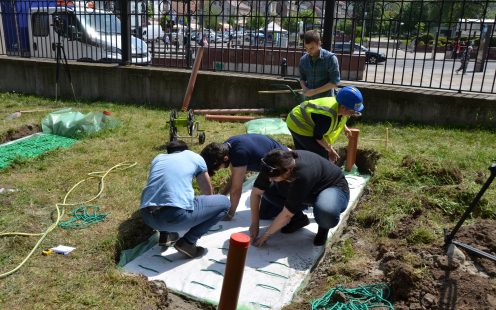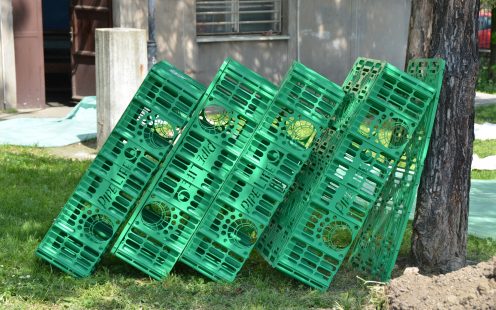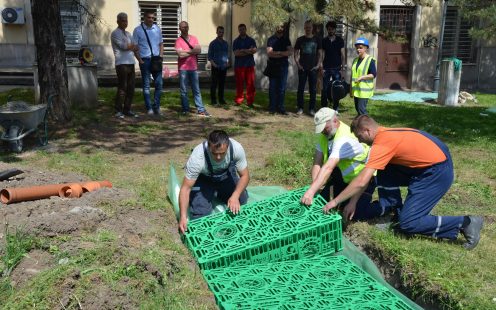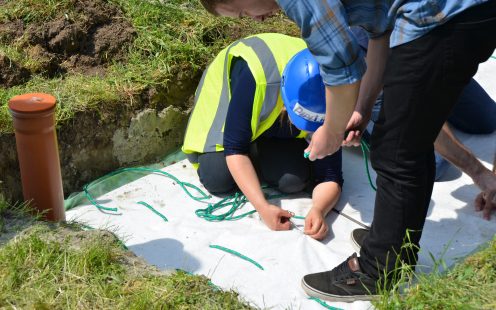Urban greening experiment with Raineo Stormboxes
Pipelife supported the Faculty of Civil Engineering at the University of Belgrade to experiment irrigation solutions in urban areas with a donation of 10 Raineo Stormboxes and installation know-how. Through a long-standing partnership with the university, Pipelife has provided mentorship and classes on “Municipal Water Supply and Wastewater” teaching students about plastic materials and urban drainage solutions.
This experiment was designed to explore the suitability of Pipelife Stormboxes as water saving subirrigation method for urban greening. Rainwater reuse provides a crucial solution to save potable water resources. Instead of using valuable tap water, rainwater could instead be collected and used to bridge drier spells.
Increasing urban greening – decreasing water consumption
Urban greening is hugely important to increase the quality of life in cities, combat air pollution and maintain biodiversity. However, there is no green without a considerable amount of water.
To encourage urban greening and to manage green spaces sustainably, cities need to adopt water saving practices. Harvesting rainwater from sealed surfaces such as roofs and storing it for reuse could save millions of cubic meters of drinking water annually. Combined with water saving irrigation techniques we can reduce the water footprint of our cities even further.
Subsurface irrigation for urban greening
Capillary irrigation belongs to the family of subsurface irrigation methods and is said to be one of the most water saving techniques. It is based on the principal of drawing water from a subsurface reservoir to the root area of the plants by capillary action (e.g. by means of a wick). The method provides autonomous passive irrigation to plants’ need, and as a result saves on water. Another reason why subsurface capillary irrigation is so efficient is because of reduced evaporation.
.jpg)
.jpg)
Testing rainwater reuse and capillary irrigation using Pipelife Stormboxes
Pipelife have been collaborating with the University of Belgrade since years, and students even use Pipelife’s technical catalogues as additional support material for their studies on plastic materials, static calculations, water management, stormwater management and reuse, etc.
Together with Pipelife Serbia, the Faculty of Civil Engineering at the University of Belgrade set up three experiment plots outside the faculty building in order to test whether capillary irrigation using rainwater stored in Raineo Stormboxes could be used to self-sufficiently water plants in urban green areas.
For the experiment, three plots were dug on the turf outside the faculty:
- One plot with grass only.
- One plot with 5 Pipelife Stormboxes, 30 cm deep, without wicks.
- One plot with 5 Pipelife Stormboxes, 30 cm deep, equipped with wicks.
Installing Raineo Stormboxes for the Setup
Since Denisa Djordjevic, Product Manager for Pipelife Serbia, was on site to speak to the students about the materials that would be used and explain the installation method.
To create a subterrain rainwater storage tank, both assembled Raineo Stormboxes were wrapped in PVC foil while the top of the Stormboxes were covered with permeable geotextile through which precipitation can enter the boxes and from where the water can also reach plant roots by capillary action.
During drier spells, when the water level in the reservoir drops too far, additional water can be fed through a PVC pipe on both sides of the Pipelife Stormbox System. The opening would also be used for inspection and monitoring water levels.
.jpg)
Pipelife Stormboxes Show Good Potential for Capillary Irrigation
Over the course of time, the faculty noticed that both plots with Pipelife Stormboxes were much greener and with thicker grass compared to the area with no Stormboxes. There was however no significant difference between the Pipelife Stormbox System equipped with wicks and the one without.
These encouraging results show that Pipelife Stormboxes without further add-ons such as wicks are a potential solution to help irrigate urban green areas that would otherwise need to be watered using municipal water.
With their modular design, Pipelife Stormboxes can be assembled in many ways, which can be especially useful for intricate urban gardens and narrow strips of grass or plants placed along roads. Despite being light in weight and therefore easy to handle and install, Pipelife’s Stormboxes are extremely sturdy and can be buried with little surface cover.
“We are delighted with the results of this experiment and very happy we could support the University of Belgrade to carry out this research with their master’s students. These results are a testament to what is possible to help make our cities more resilient and greener. We are certain that there are still plenty of possibilities to explore for saving water resources”, concludes Denisa.
.jpg)
FOR FURTHER INFORMATION ON THE PROJECT:
Fill our form